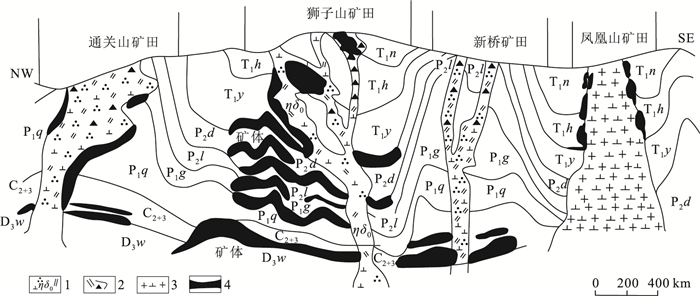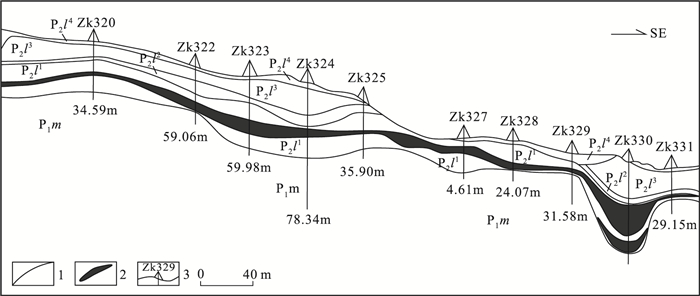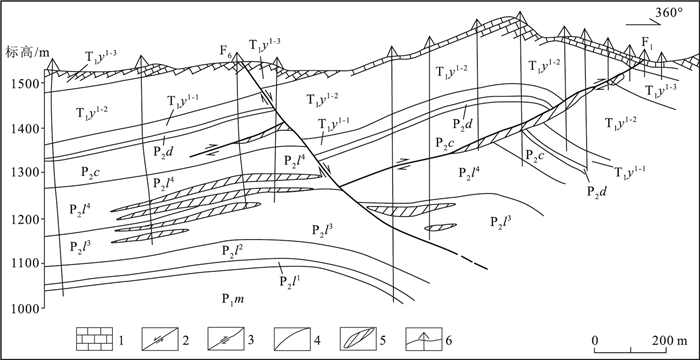Ore-controlling and metallogenic role of interlayer-slide fault in the carbonate formation, southern China
-
摘要:
碳酸盐岩系层滑断裂在中国南方古生代地层中广泛分布,是一种重要的控矿和成矿构造。厘定碳酸盐岩系层滑断裂的基本类型、形成机理和控矿作用对相关矿床的找矿具有重要意义。基于层滑断裂所属含矿岩系的岩性组合、构造样式及其与主干断裂的相互关系,初步将层滑断裂划分为4种基本类型,即碳酸盐岩与泥页岩界面+层滑断裂复合型,平行不整合面+层滑断裂复合型,逆冲推覆构造台阶式断层断坡+断坪复合型和陡倾斜主干断层+旁侧缓倾斜层滑断裂复合型,分别总结了不同类型层滑断裂的控矿特征,并列举其典型的矿床实例,讨论了层滑断裂的控矿作用和成矿作用,将层滑断裂的形成过程归纳为层间滑动、层滑断层、叠加断层3个阶段。
Abstract:The interlayer-slide faults in the carbonate series are widely distributed in the Paleozoic strata in southern China. These faults constitute an important ore-controlling and forming structure. Determining the basic types, formation mechanism, and ore-controlling effects of the interlayer-slide faults is of great significance in the search for related deposits. Based on the lithological combination of the ore-bearing rock series, structural style and the relationship with the main fault, the authors divided the interlayer-slide faults into four basic types:the compound type of carbonate and shale boundary with interlayer-slide fault, the disconformities boundary with interlayer-slide fault, the thrusting nappe structure with stepped ramp and flat, and steeper slope master fault with gently inclined secondary interlayer-slide faults. The ore-controlling characteristics of different types of interlayer faults and typical examples were introduced and the roles of interlayer faults in ore-controlling and metallogenic process was discussed. Three stages of the formation of the interlayer-slide fault were summarized, which are slide fault in interlayer, interlayer-slide fault and superimposed fault.
-
Keywords:
- carbonate /
- interlayer-slide fault /
- basic type /
- ore-controlling functions /
- metallogenesis
-
致谢: 感谢审稿专家对本文提出的中肯修改意见。
-
图 1 铜陵矿集区重要矿田构造分层成矿特征示意图
T1n—南陵湖组灰岩;T1h—和龙山组条带状灰岩;T1y—殷坑组钙质泥页岩;P2d—大隆组硅质岩;P2l—龙潭组长石石英砂岩;P1g—孤峰组灰岩、硅质岩;P1q—栖霞组硅质灰岩;C2+3—中上石炭统白云质灰岩、生屑微晶灰岩;D3w—五通组页岩、泥岩石英砂岩;1—石英二长闪长岩;2—角砾岩;3—花岗闪长岩;4—矿层
Figure 1. Diagram of structural layered ore-forming characteristics of the major orefields in the Tongling ore concentration area
图 3 紫木凼金矿区32线勘探剖面(据参考文献[19]修改)
T1y1-3、T1y1-2、T1y1-1—夜郎组第一段第三、第二、第一层;P2d—大隆组;P2c—长兴组;P2l4、P2l3、P2l2、P2l1—龙潭组第四、第三、第二、第一段;P1m—茅口组;1—灰岩; 2—正断层;3—逆冲断层;4—地层界线;5—金矿体;6—勘探线
Figure 3. Geological section along No. 32 exploration line in the Zimudang gold deposit
图 4 凡口矿区208号勘探线地质剖面[12]
1—天子岭组中亚组与下亚组分界线;2—断层及编号;3—辉绿岩脉;4—矿体及编号;5—钻孔及编号;6—探矿穿脉
Figure 4. Geological section along No. 208 exploration line in the Fankou gold deposit
表 1 碳酸盐岩系层滑断裂矿床实例
Table 1 Example of the deposit of the interlayer-slide fault in the carbonate formation
矿床
名称赋矿地层 岩性组合 控矿
构造矿体
特征矿物组合 矿石结构构造 蚀变特征 构造控矿作用 构造-变形序列 铜陵狮
子山矽
卡岩型
铜金
矿床上泥盆统五通组—下三叠统南陵湖组共6个层位,其中中石炭统黄龙组矿化最为集中 砂岩、页岩、碳酸盐岩、硅质岩等 多层次层滑断裂系 多呈层状、似层状 金属矿物为磁黄铁矿、黄铁矿、黄铜矿、磁铁矿、银金矿、自然金等;
非金属矿物为石榴子石、透辉石、石英及方解石等块状、浸染状、脉状、条带状与条纹状构造;自形晶粒状、半自形-他形粒状、交代结构等 矽卡岩化、钾化、硅化、绿泥石化、绿帘石化和绢云母化 多层楼控矿模式:多重多层滑脱构造控制多层状矿体,2期滑脱构造叠加部位控制了花树坡、老鸦岭矿床是上泥盆统和中上石炭统含碳胶状黄铁矿、菱铁矿、石膏层的特殊岩性层提供了铜金溶液沉淀有利的地球化学障壁 矿区主体构造演化表现为:印支期北东向褶皱→燕山早期东西向褶皱,不同方位、性质的构造变形复合叠加促进多方向多层次的滑脱[8],表现在北东向褶皱枢纽的波状起伏和褶皱面上的多向擦痕[9] 贵州戈
塘金
矿床下二叠统茅口组、上二叠统龙潭组 粉砂岩、粉砂质粘土岩、炭质粘土岩、硅化灰岩、硅化灰岩角砾岩 平行不整合面与层滑断裂
组合矿体产状平缓,呈层状、似层状 金属矿物以黄铁矿、辉锑矿、褐铁矿为主,毒砂、雄黄、雌黄、铜蓝次之;
非金属矿物以萤石、石英、石膏、方解石为主角砾状、块状、浸染状、晶洞状、网脉状、土状构造等;胶状环带、泥质、土状、假象结构 硅化、黄铁矿化、褐铁矿化、辉锑矿化、萤石化为主,高岭土化、碳酸盐化、粘土化、雄黄化等次之 层滑+岩溶不整合面双重控矿模式:矿体产出部位受层滑断裂和古岩溶不整合面双重控制,下二叠统灰岩之上岩溶不整合面为主滑面。层滑断裂既是导矿构造亦是容矿构造,富矿体形态受下二叠统茅口组岩溶凹陷控制。上二叠统龙潭组富碳质层提供了含金溶液沉淀有利的地球化学障壁 矿区印支晚期北东向挤压→燕山早期北西西向挤压,2期构造叠加形成戈塘穹窿构造[14],表现在层滑断裂带出现一系列北西西向叠瓦式断裂和面理[15]。燕山晚期北西西向正滑层滑断裂张开为含金溶液充填提供了有利的空间,表现在矿体产状变陡处厚度显著增大[21],矿体内部广泛发育的角砾状[22]、晶洞状和网脉状构造 贵州紫
木凼金
矿床上二叠统龙潭组、下三叠统夜郎组 砂岩、粉砂岩、泥岩、灰岩和白云岩 逆冲推覆台阶式断层断坡+断坪复合型 层状、似层状、透镜状 金属矿物主要有黄铁矿、毒砂,白铁矿、雄黄、雌黄、闪锌矿、辉锑矿等;
非金属矿物主要有石英、方解石、白云石,白云母、萤石、玉髓、粘土矿物等星散浸染状、脉状网脉状、晶洞状、生物遗迹、角砾状、条纹状构造等;
他形、假象、胶状、交代残余、环带状、重结晶、包含、压碎、草莓状结构等硅化、白云石化、黄铁矿化为主,毒砂化、雄(雌)黄化、粘土化、萤石化等次之 台阶式逆冲推覆断层成矿模式:由下部上二叠统龙潭煤系地层顺层滑动形成的层滑断裂——断坪控矿(层控)和上部上二叠统大隆组和长兴组灰岩穿层形成的逆冲断层——断坡控矿(断控)。兼具导矿和容矿作用,但断层不同部位产状不同,控矿特征差异较大。煤系地层提供富硫富碳的有利环境和矿液运移的屏蔽盖层 矿区印支晚期北东向挤压形成灰家堡短轴背斜及伴生的北西西向逆冲推覆构造系统;燕山早期北西西向挤压,使北西向断裂张开为含金溶液充填 广东凡
口铅锌
矿矿床中泥盆统桂头组、棋梓桥组、上泥盆统佘田桥组、锡矿山组 浅变质碎屑岩、灰岩、不纯碳酸盐岩 主断裂旁侧之层滑断裂系 似层状矿体、透镜状矿体、楔板状矿体、脉状矿体、不规则状矿体等 金属矿物主要有黄铁矿、闪锌矿、方铅矿等;
非金属矿物:石英、绢云母、方解石、白云石等浸染状、层纹状、变形层纹状、条带状、不规则脉状、细脉网脉状、块状、斑点状、复杂环带状、角砾状;
自形晶粒状、半自形晶粒状、他形晶粒状、显微球粒、定向乳滴状、定向叶片状、包含、交代溶蚀、交代残余、细脉网脉交代、骸晶、斑状变晶、变胶状结构方解石化、白云石化、菱铁矿化、绢云母化、绿泥石化、硅化及黄铁矿化 陡倾斜主断裂与缓倾斜层滑断裂交切组合控矿模式:以F3为代表的北北东陡倾斜断裂作为主要的导矿构造控制了矿带的展布,其旁侧的层间滑动构造控制了矿体的定位,与陡倾斜断裂交接部位形成富厚矿体,远离则变薄以致尖灭。早期沉积的硫铁矿层为铅锌矿液沉淀提供了富硫富铁的矿源层条件 海西—印支期北东向挤压形成矿区北西向一组倾伏褶皱及伴生层间滑动构造系统;燕山期北西西向挤压形成一组北北东陡倾斜断裂,含铅锌热液沿F3、F4、F5、F6等北北东向断裂上侵,在断裂邻侧的层间断裂和虚脱部位交代充填成矿[23] 表 2 灌阳地区泥盆系碳酸盐岩层滑断裂不同分带元素平均含量、离差和变化系数
Table 2 Average content, deviation and variation coefficients of elements in different zones of the interlayer-slide fault in the carbonate formation in Guanyang area
分带 统计
参数元素及氧化物 SiO2 Al2O3 CaO MgO FeO Fe2O3 CO2 Ba Cr V Sr Mn CO Ni Cu Pb Zn Ag Bi Ga 原岩(泥
晶灰岩)
n=10X 0.91 0.81 52.53 1.25 0.098 0.075 41.62 12.50 20.90 13.8 488 37.1 28.35 19.2 5.05 9.1 26.8 0.151 1.55 5.06 σn-1 0.67 0.19 0.65 1.53 0.053 0.083 0.58 2.12 4.53 6.23 179.5 14.4 6.44 9.69 6.59 5.20 18.0 0.096 0.30 1.98 S 0.74 0.24 0.012 1.23 0.54 1.116 0.014 0.17 0.22 0.45 0.37 0.39 0.23 0.51 1.31 0.57 0.70 0.63 0.19 0.39 同构造重
结晶方解
石n=8X 1.96 1.38 51.74 0.46 0.100 0.19 40.34 12.60 22.40 19.40 592. 45.4 28.20 22.60 14.4 9.40 23.20 0.16 1.78 5.04 σn-1 1.79 0.70 1.41 0.29 0.035 0.20 1.21 2.79 1.67 5.32 138 10.1 2.12 0.23 11.40 1.34 13.72 0.33 0.38 1.53 S 0.96 0.50 0.027 0.62 0.35 1.05 0.030 0.22 0.075 0.27 0.23 0.22 0.075 0.28 0.79 0.14 0.59 0.21 0.22 0.30 劈理带
n=4X 1.65 1.29 50.27 0.43 0.133 0.227 40.55 16 25 26.67 716 41.7 31.97 31.33 21.67 15.33 30.7 0.237 1.94 6.83 σn-1 0.09 0.31 1.37 0.42 0.029 0.111 1.47 0 4 1.53 74.9 17.9 2.41 7.02 12.06 6.66 11.6 0.038 0.41 2.48 S 0.054 0.24 0.027 0.97 0.217 0.49 0.036 0 0.16 0.057 0.11 0.43 0.075 0.22 0.56 0.41 0.38 0.16 0.21 0.36 裂隙充填
方解石脉
n=7X 0.29 0.79 52.93 0.36 0.094 0.173 41.72 9.93 14.86 10.86 146 33.7 26.46 15.29 4.36 7.00 31.14 0.094 1.21 3.47 σn-1 0.38 0.22 0.57 0.44 0.044 0.196 0.98 4.17 6.12 2.27 79 9.3 5.53 7.97 3.92 1.29 17.43 0.033 0.39 0.90 S 1.30 0.28 0.011 1.24 0.17 1.14 0.023 0.42 0.41 0.21 0.54 0.28 0.21 0.52 0.99 0.18 0.56 0.35 0.32 0.26 注:氧化物含量单位为×10-2;元素含量单位为×10-6;n为样数;X为平均值;σn-1为均方差;S为变化系数;分析单位:主量元素为桂林理工大学;微量元素为桂林矿产研究院 -
马杏垣, 索书田.论滑覆及岩石圈内多层次滑脱构造[J].地质学报, 1984, 19(3):205-213. http://www.cnki.com.cn/Article/CJFDTotal-DZXE198403003.htm 彭美丽, 易金, 姚蓉, 等.华南多层推滑构造系的物理模拟实验[J].大地构造与成矿学, 2011, 35(2):198-206. http://www.cnki.com.cn/Article/CJFDTotal-DGYK201102005.htm 王步清, 彭恩生, 唐诗佳, 等.广西泗顶铅锌矿层间滑动带地质特征及控矿作用[J].广西地质, 2000, 13(2):35-38. http://www.cnki.com.cn/Article/CJFDTotal-GXDZ200002007.htm 常印佛, 刘学圭.关于层控式矽卡岩型矿床——以安徽省内下扬子坳陷中一些矿床为例[J].矿床地质, 1983, 2(1):11-20. http://www.cnki.com.cn/article/cjfdtotal-kcdz198301001.htm 孙岩, 沈修志, 黄钟瑾.层滑断裂与层控矿床——以苏皖南部上古生界的地层为例[J].地质论评, 1984, 30(5):430-436. http://www.cnki.com.cn/Article/CJFD1984-DZLP198405004.htm 凌其聪, 周贵斌, 黄许陈, 等."层控式"矽卡岩征床特征及成矿机制[J].贵金属地质, 1998, 7(2):91-95. 吴淦国, 张达, 臧文拴.铜陵矿集区构造滑脱与分层成矿特征研究[J].中国科学, 2003, 33(4):300-308. http://d.wanfangdata.com.cn/Periodical_zgkx-cd200304002.aspx 黄许陈, 储国正.铜陵狮子山矿田多位一体(多层楼)模式[J].矿床地质, 1993, 12(3):221-252. http://www.cnki.com.cn/Article/CJFDTotal-KCDZ199303004.htm 储国正.铜陵狮子山矿田构造及其控岩控矿作用的研究[J].安徽地质, 1992, 2(2):1-14. http://www.cqvip.com/QK/87123X/19922/1005212429.html 刘经华, 李卉, 徐兆文, 等.冬瓜山层状铜矿成矿地质背景及成因[J].地质学刊, 2009, 33(2):133-137. http://www.cnki.com.cn/Article/CJFDTotal-JSDZ200902010.htm 杨汉壮, 陈尚周.广东凡口铅锌矿层间滑动构造及其控矿作用[J].地质与勘探, 2006, 42(2):44-48. http://d.wanfangdata.com.cn/Periodical/kcdz200602008 原桂强, 贾会业, 宋玉伟, 等.凡口铅锌矿狮岭南深部矿床地质特征及找矿方向[J].地质学刊, 2019, 43(1):1-7. http://d.wanfangdata.com.cn/periodical/jsdz201901001 毛健全, 杜定全, 潘年勋, 等.滑脱构造与黔西南地区金矿浅析[J].贵州工学院学报, 1990, 19(3):44-49. http://www.cnki.com.cn/Article/CJFDTotal-GZGX199003005.htm 钱建平.黔西南微细浸染型金矿基本特征和几点认识[J].桂林工学院学报, 2001, 21(1):27-34. http://d.wanfangdata.com.cn/Periodical/glgxy200101005 何丰胜, 毛健全, 杜定全.戈塘矿区层滑构造研究[J].贵州工业大学学报, 1997, 26(2):10-16. http://www.cnki.com.cn/Article/CJFDTotal-GZGX702.002.htm 袁远, 董从芳, 刘伯胜.广西黑水沟-大树脚锌多金属矿地质特征及外围找矿远景分析[J].2012, 3(3): 330-333. 张开均, 李扬.皖南台阶式逆冲断层控矿[J].地质与勘探, 1994, 30(3):14. http://www.cnki.com.cn/Article/CJFDTotal-DZKT403.002.htm 张开均, 施央申.长江中下游多金属成矿带逆冲推覆构造的控矿作用初探[J].江苏地质, 1996, 20(3):172-176. http://www.cqvip.com/QK/96560X/199603/2412119.html 郭振春.黔西南灰家堡金矿田"两层楼"模式及找矿意义[J].黄金地质, 2002, 8(4):18-23. http://www.cnki.com.cn/Article/CJFDTotal-HJDZ200204003.htm 张蕾, 杜定全, 张晗彬, 等.黔西南灰家堡金矿田的构造控矿模式研究——"两层楼"模式的构造意义[J].黄金, 2012, 33(9):13-18. http://www.cnki.com.cn/Article/CJFDTotal-HJZZ201209003.htm 吴松洋, 丁俊, 陈明, 等.贵州戈塘金矿滑脱构造及其与成矿的关系[J].金属矿山, 2014, (7):106-109. http://d.wanfangdata.com.cn/periodical/jsks201407023 刘帅, 张培兴, 熊灿娟, 等.贵州戈塘金矿SBT地球化学研究[J].贵州大学学报(自然科学版), 2013, 30(5):43-48. http://www.cnki.com.cn/Article/CJFDTotal-GZDI201305011.htm 黎应书, 祡大博, 贺磊.广东省仁化县凡口铅锌矿田构造体系[J].有色金属(矿山部分), 2018, 70(1):46-49. http://www.cnki.com.cn/Article/CJFDTotal-YSKU201801010.htm 李存有.高龙金矿同位素地球化学特征及其地质意义[J].贵金属地质, 1994, 3(2):123-130. http://www.cnki.com.cn/Article/CJFDTotal-GJSD199402006.htm 钱建平.黔西北威宁-水城铅锌矿带动力成矿作用研究[J].地质地球化学, 2001, 29(3):134-139 http://d.wanfangdata.com.cn/conference/235550 刘俊来, 俞保祥, Weber K.浅成断层带的低温脆-韧性破裂共生机制[J].科学通报, 1999, 44(8):864-869. http://www.cnki.com.cn/Article/CJFDTotal-KXTB199908017.htm 刘俊来, 岛田充彦.实验变形岩石低温破裂作用的微观机制[J].地质科学, 1999, 34(2):242-250. http://www.cnki.com.cn/Article/CJFDTotal-DZKX902.011.htm Griggs D T, Blacic J D.Quartz:Anomalous weakness of synthetic crystals[J].Science, 1965, 147(3655):292-295. doi: 10.1126/science.147.3655.292
Griggs D T. A model of hydrolytic weakening in quartz[J]. J.Geophys. Res., 1974, 79(11):1653-1611. doi: 10.1029/JB079i011p01653
Kekulawala K, Paterson M S. Boland J N. Hydrolytic weakening in quartz[J].Tectonophysics, 1978, 46(1/2):T1-T6. https://www.sciencedirect.com/science/article/abs/pii/0040195178901014
Kronenberg A K, Tullis J. Flow strengths of quartz aggregates:grain size and pressure effects due to hydrolytic weakening[J]. Journal of Geophysical Research, 1984, 89(B6):4281-4297. doi: 10.1029/JB089iB06p04281
钱建平.广西灌阳地区碳酸盐岩层滑断裂构造地球化学系统[J].矿物学报, 1994, 14(4):348-356. http://www.cnki.com.cn/Article/CJFDTotal-KWXB199404005.htm 白嘉芬, 王长怀, 纳荣仙.云南金顶铅锌矿床地质特征及成因初探[J].矿床地质, 1985, 4(1):1-10. http://www.cnki.com.cn/Article/CJFD1985-KCDZ198501000.htm 张乾.云南金顶铅锌矿床成因研究[J].地质找矿论丛, 1991, 6(2):47-58. http://www.cnki.com.cn/Article/CJFDTotal-DZZK199102004.htm 杨开庆, 董法先, 王建平, 等.海南石碌矿区铁、金、铜、钻矿构造动力成矿作用的研究[J].中国地质科学院地质力学研究所所刊, 1988, 第11号:83-152. http://www.cnki.com.cn/Article/CJFDTotal-DZLX198800001.htm 杨兴科, 宫同伦.铅峒山铅锌矿床动力热液成矿特征[J].西安地质学院学报, 1992, 14(1):35-42. http://www.cnki.com.cn/Article/CJFDTotal-XAGX199201006.htm 钱建平.伸展作用与高龙金矿成矿作用研究[C]//全国矿床资源发展战略及隐伏矿床寻找学术研讨会.2001. 沈远超, 刘铁兵, 杨金中.层间滑动角砾岩型金矿床的地质特征及成矿远景[J].矿物岩石地球化学通报, 2000, 19(4):271-272. http://www.cnki.com.cn/Article/CJFDTotal-KYDH200004023.htm 钱建平.构造动力成矿理论若干问题的探讨[J].地质地球化学, 2002, 30(4):1-6. http://www.cnki.com.cn/Article/CJFDTotal-DZDQ200204000.htm 夏玉成, 王生全, 樊怀仁.显德汪井田构造薄煤带形成机理及预测[J].河北煤炭, 1997, (2):27-29. http://www.cnki.com.cn/Article/CJFDTotal-HBMT199702015.htm 琚宜文, 姜波, 王桂梁, 等.层滑构造煤岩体微观特征及其应力应变分析[J].地质科学, 2004, 39(1):50-62. http://www.cnki.com.cn/Article/CJFDTotal-DZKX200401006.htm 靳尊秀.层间滑动构造探讨[J].河北煤炭, 1988, (3):50-53. http://www.cnki.com.cn/Article/CJFDTotal-HBMT198803033.htm




 下载:
下载:



